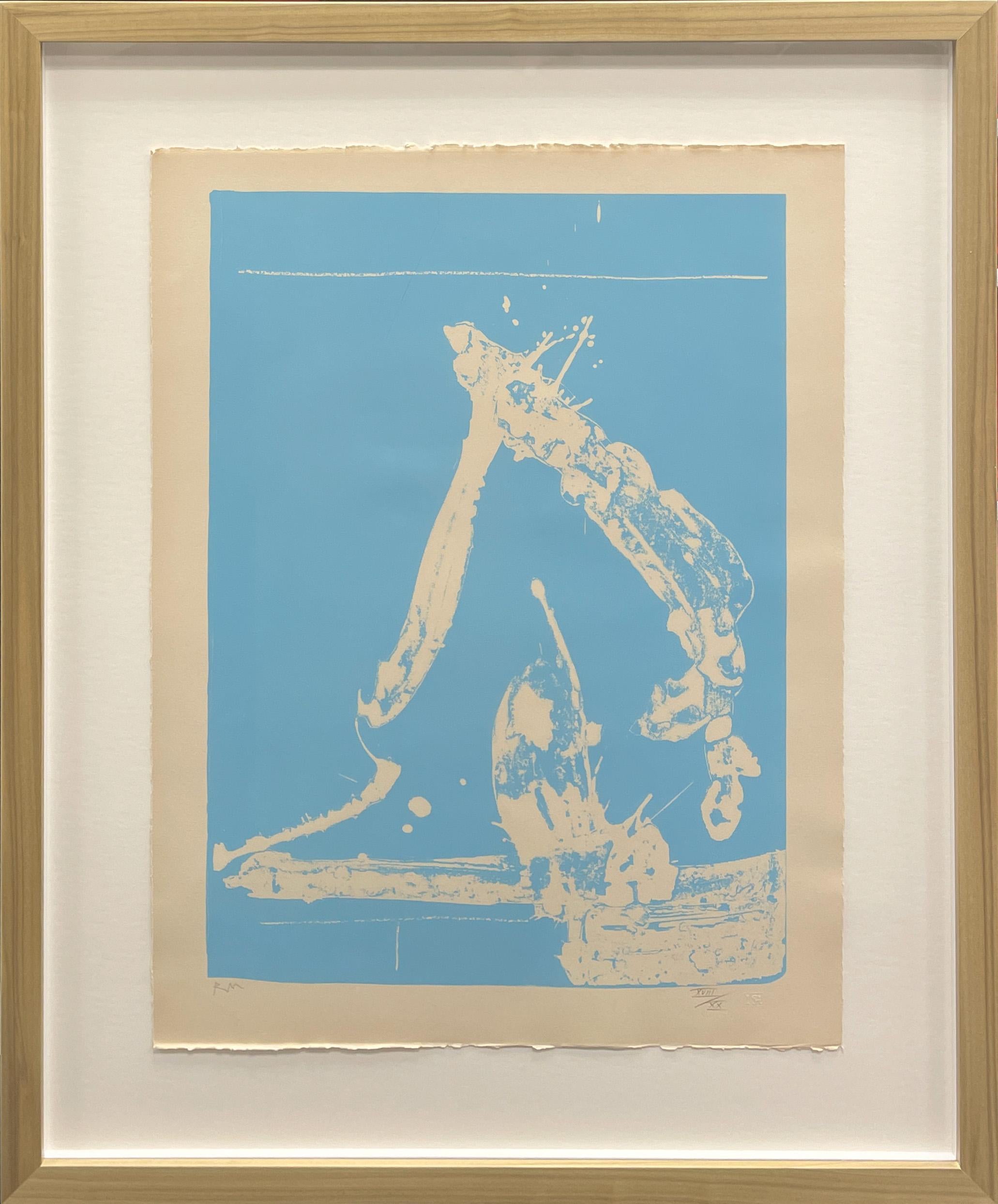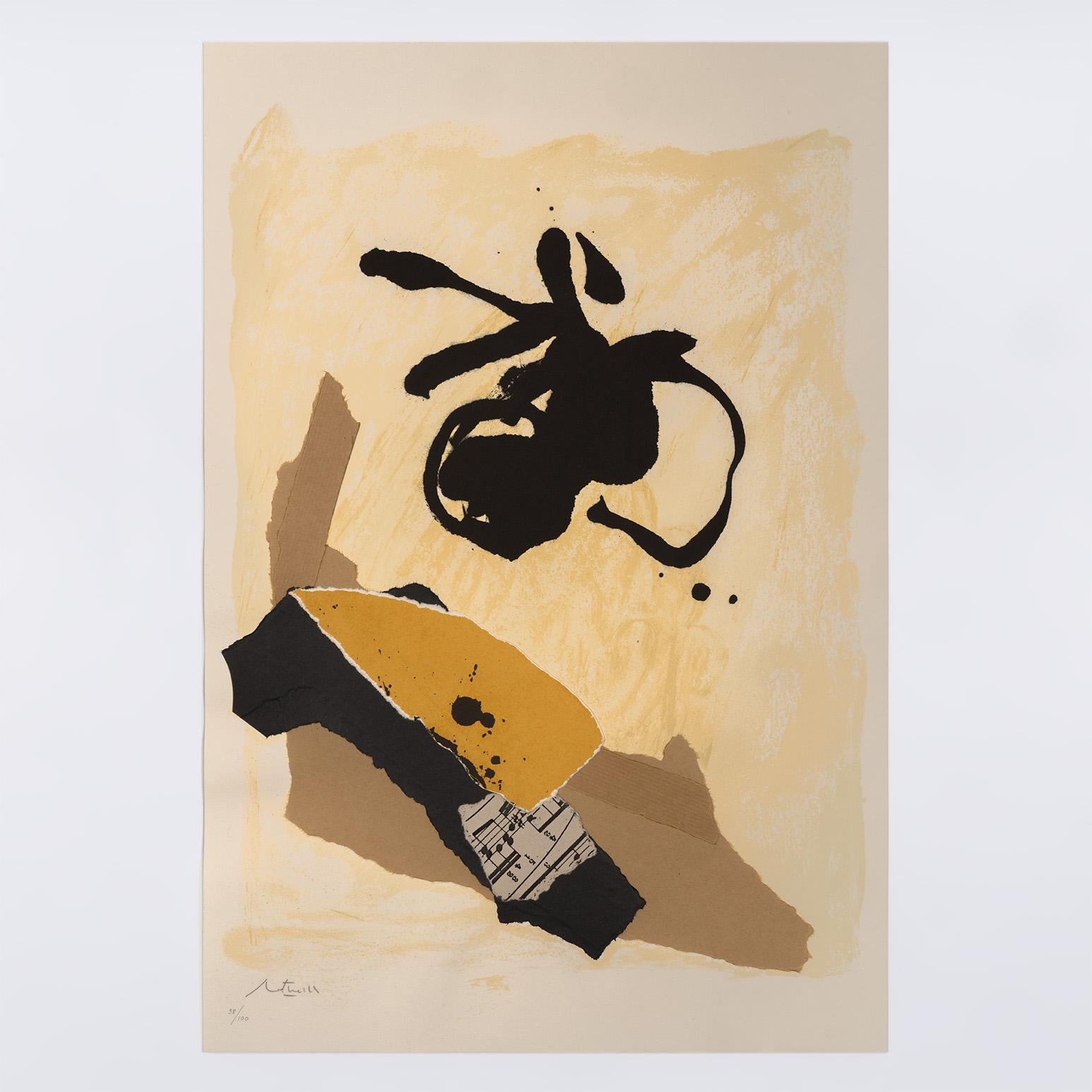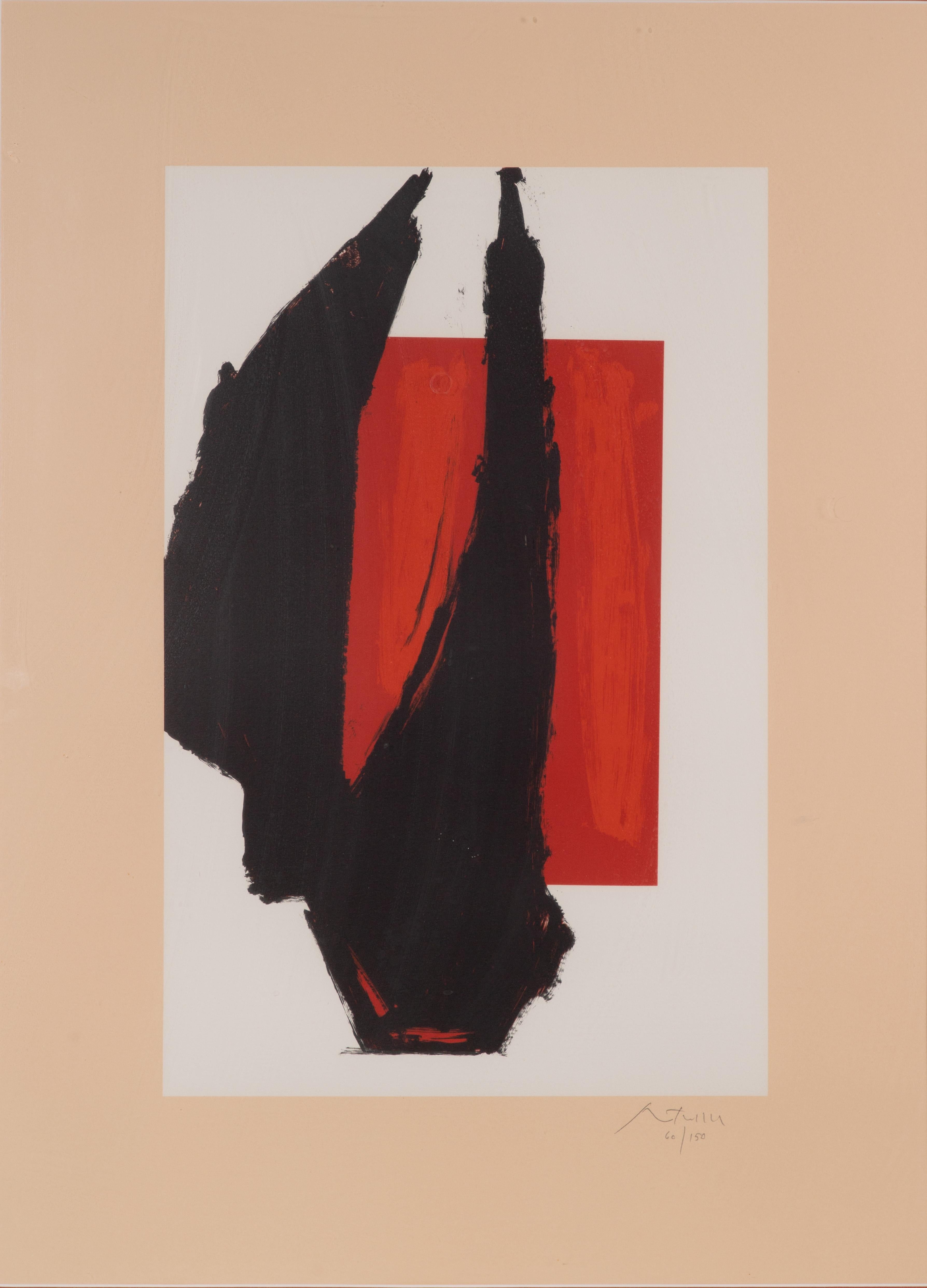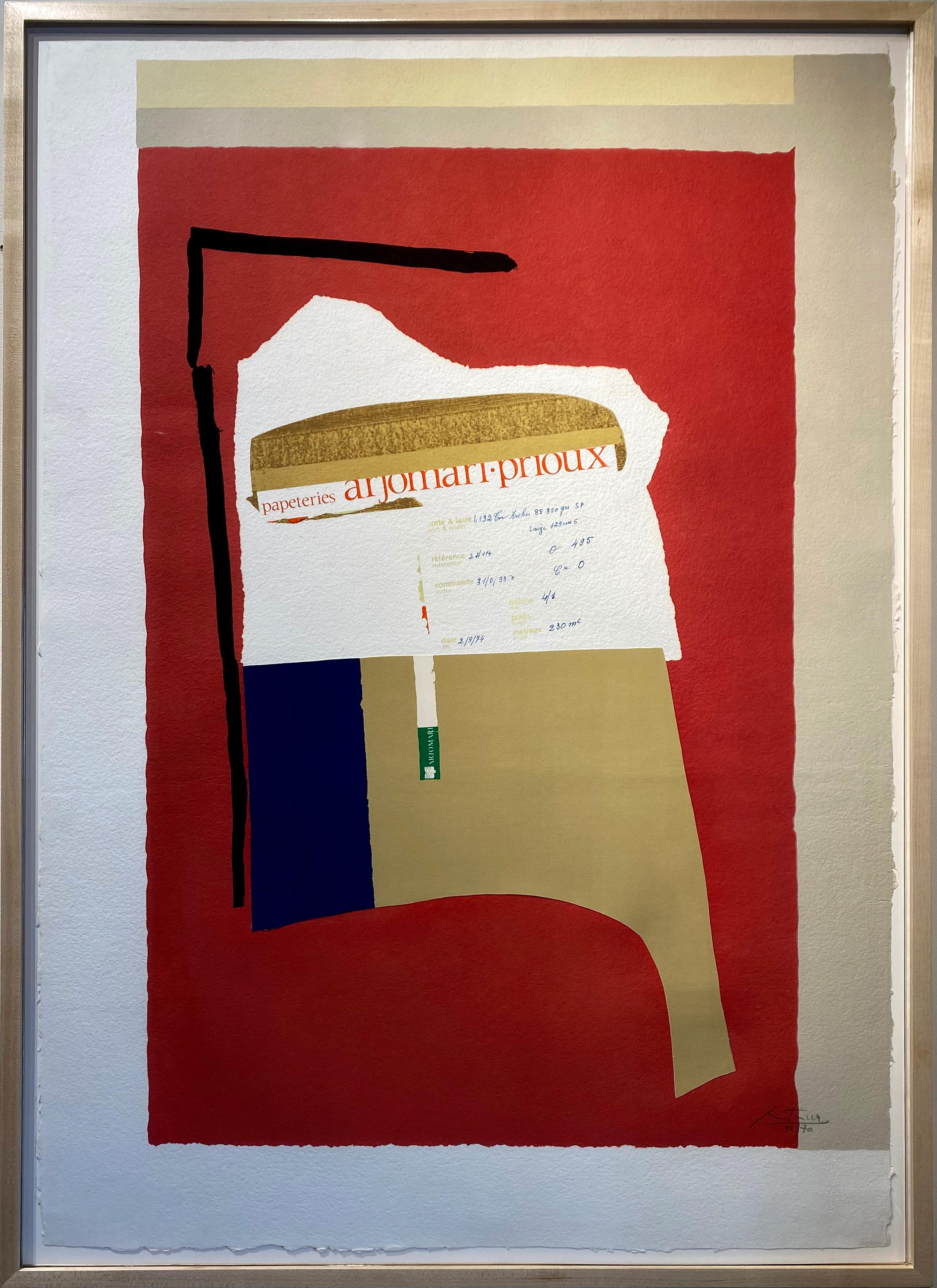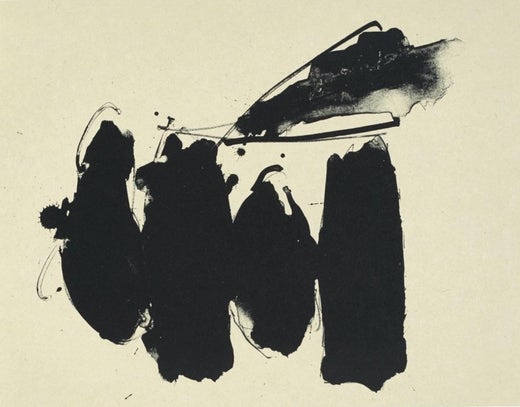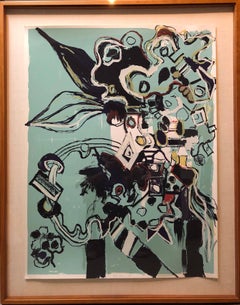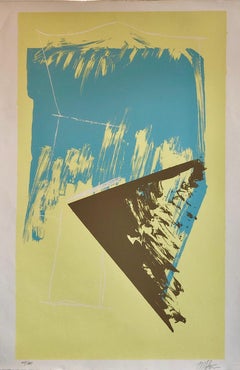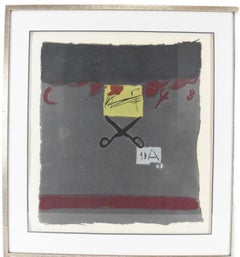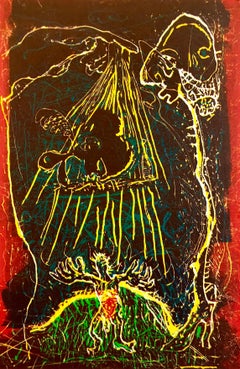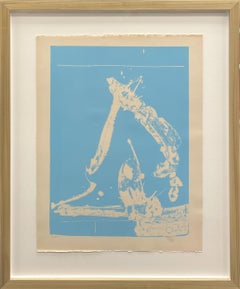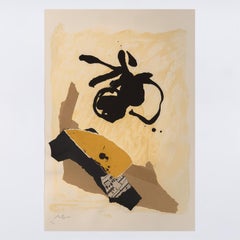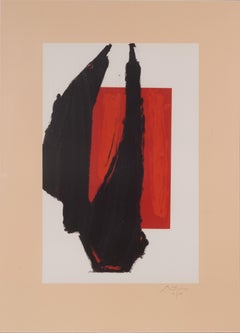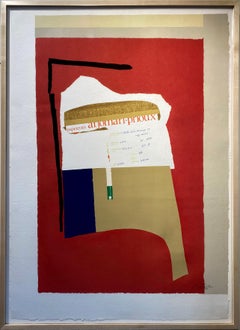Robert Motherwell, American, 1915-1991
St. Michel III
1979
Lithograph and Screenprint
On handmade paper
Hand signed in white pencil and numbered 71/99.
Dimensions: Sight 40 3/4 x 32 1/2 in. Overall 45 1/2 x 37 in.
Publisher's blind stamp, Tyler Graphics Ltd., Bedford Village, New York.
Printed by John Hutcheson (plates) and Kim Halliday (screen) with deckled edges.
LITERATURE:
Engberg/Banach, 237;
Belknap, 206;
Tyler Graphics, 398.
Robert Burns Motherwell American (1915-1991) was an American abstract expressionist painter, printmaker, and editor of The Dada Painters and Poets: an Anthology. He was one of the youngest of the New York School, which also included Willem de Kooning, Jackson Pollock, and Mark Rothko. Trained in philosophy, Motherwell then became an artist regarded as among the most articulate spokesmen and founders of abstract expressionism.
Between 1932 and 1937, Motherwell briefly studied painting at California School of Fine Arts, San Francisco and received a BA in philosophy from Stanford University. At Stanford, Motherwell was introduced to modernism through his extensive reading of symbolist and other literature, especially Mallarmé, James Joyce, Edgar Allan Poe, and Octavio Paz. This passion stayed with Motherwell for the rest of his life and became a major theme of his later paintings and drawings.
At the age of 20, Motherwell took a grand tour of Europe, accompanied by his father and sister. They began in Paris, then traveled to Amalfi, Italy. The next stops were Switzerland, Germany, The Netherlands and London. The group ended their tour in Motherwell, Scotland.
Later at Harvard, Motherwell studied under Arthur Oncken Lovejoy and David Wite Prall. He spent a year in Paris to research the writings of Eugène Delacroix, where he met American composer Arthur Berger who advised him to continue his education at Columbia University, under Meyer Schapiro. In 1939, Lance Wood Hart, then a professor of drawing and painting at the University of Oregon, invited Motherwell to join him in Eugene, OR to assist in teaching his classes for a full semester.
In 1940, Motherwell moved to New York to study at Columbia University, where he was encouraged by Meyer Schapiro to devote himself to painting rather than scholarship. Schapiro introduced the young artist to a group of exiled Parisian Surrealists (Max Ernst, Marcel Duchamp, Andre Masson) and arranged for Motherwell to study with Kurt Seligmann. The time that Motherwell spent with the Surrealist artists proved to be influential to his artistic process. After a 1941 voyage with Roberto Matta to Mexico—on a boat where he met Maria Emilia Ferreira y Moyeros, an actress and his future wife.
Motherwell's noted Mexican Sketchbook visually reflects the resulting change: while the first drawings are influenced by Matta and Yves Tanguy, later drawings associated with Motherwell's time with Paalen show more plane graphic cadences and details distinguished from the earlier period. Paalen also introduced Motherwell to André Breton.
Upon return from Mexico Motherwell spent time developing his creative principle based on automatism: "What I realized was that Americans potentially could paint like angels but that there was no creative principle around, so that everybody who liked modern art was copying it. Arshile Gorky was copying Pablo Picasso. Pollock was copying Picasso. De Kooning was copying Picasso. Thus, in the early 1940s, Robert Motherwell played a significant role in laying the foundations for the new movement of abstract expressionism (or the New York School): "Matta wanted to start a revolution, a movement, within Surrealism. He asked me to find some other American artists that would help start a new movement. It was then that William Baziotes and I went to see Pollock and de Kooning and Hans Hofmann and Gerome Kamrowski and Paul Busa and several other people. And if we could come with something. Peggy Guggenheim who liked us said that she would put on a show of this new business. And so I went around explaining the theory of automatism to everybody because the only way that you could have a movement was that it had some common principle. It sort of all began that way."
In 1942 Motherwell began to exhibit his work in New York and in 1944 he had his first one-man show at Peggy Guggenheim's "Art of This Century" gallery; that same year the MoMA was the first museum to purchase one of his works. From the mid-1940s, Motherwell became the leading spokesman for avant-garde art in America. His circle came to include William Baziotes, David Hare, Barnett Newman, and Mark Rothko, with whom he eventually started the Subjects of the Artist School (1948–1949).
Motherwell was a member of the editorial board of the Surrealist magazine VVV and a contributor to Wolfgang Paalen's journal DYN, which was edited from 1942 to 1944 in six issues. He also edited Paalen's collected essays Form and Sense in 1945 as the first issue of Problems of Contemporary Art.
In 1948, Motherwell, William Baziotes, Barnett Newman, David Hare, and Mark Rothko founded the Subjects of the Artist School at 35 East 8th Street. Well attended lectures were open to the public with speakers such as Jean Arp, John Cage and Ad Reinhardt. The school failed financially and closed in the spring of 1949. Throughout the 1950s Motherwell taught painting at Hunter College in New York and at Black Mountain College in North Carolina. Cy Twombly, Robert Rauschenberg and Kenneth Noland studied under and were influenced by Motherwell. At this time, he was a prolific writer and lecturer, and in addition to directing the influential Documents of Modern Art Series, he edited The Dada Painters and Poets: An Anthology, which was published in 1951.
From 1954 to 1958, during the break-up of his second marriage, he worked on a small series of paintings which incorporated the words Je t'aime, expressing his most intimate and private feelings. His collages began to incorporate material from his studio such as cigarette packets and labels, becoming records of his daily life. He was married for the third time, from 1958 to 1971, to fellow abstract painter Helen Frankenthaler. Because Frankenthaler and Motherwell were both born into wealth and known to host lavish parties, the pair were known as "the golden couple".
In 1958–59, Motherwell was included in "The New American Painting" exhibition, initiated by the Museum of Modern Art, which traveled across Europe. The late 1960s saw Motherwell using Gauloises packets and cartons in many collages, including an extensive series with the packets surrounded by bright red acrylic paint, often with incised lines in the painted areas.
In 1972 Motherwell married the artist-photographer Renate Ponsold and moved to Greenwich, Connecticut, Motherwell set up different studios for different modes of production (painting, collage, printmaking) During the 1970s, he had retrospective exhibitions in several European cities, including Düsseldorf, Stockholm, Vienna, Paris, Edinburgh, and London. In 1977, Motherwell was given a major mural commission for the new wing of the National Gallery of Art in Washington, D.C.
In 1983, a major retrospective exhibition of Motherwell's work, organized by Douglas G. Schultz, was held at the Albright-Knox Art Gallery in Buffalo, New York.
From 1983 to 1985,[ this exhibition was subsequently shown at major museums, Los Angeles County Museum of Art San Francisco Museum of Modern Art, Seattle Art Museum, Corcoran Gallery of Art, and Solomon R. Guggenheim Museum. Another retrospective was shown in Mexico City, Monterey, and Fort Worth, Texas, in 1991.
In 1985, Motherwell was awarded the Edward Macdowell Medal.
In 1988, Motherwell worked with the publisher Andrew Hoyem of Arion Press on a limited edition of the modernist novel Ulysses, by James Joyce. Motherwell produced 40 lithographs for the project.
Motherwell died in Provincetown, Massachusetts on July 16, 1991. On his death, Clement Greenberg, champion of the New York School, left in little doubt his esteem for the artist, commenting that "although he is underrated today, in my opinion he was one of the very best of the abstract expressionist painters".
The Dedalus Foundation was set up by Robert Motherwell in 1981 to foster public understanding of modern art and modernism through its support of research, education, publications, and exhibitions. On July 20, 1991, several hundred people attended a memorial service for Motherwell on the beach outside his Provincetown home. Among them were the writer Norman Mailer and the photographer Joel Meyerowitz, both Provincetown summer residents. Speakers included the poet Stanley Kunitz, who read a poem that was a favorite of Motherwell's, William Butler Yeats's Sailing to Byzantium. Others in attendance included family members, friends, other artists, and Senator Howard Metzenbaum, an acquaintance of Motherwell's.
Major exhibitions of Motherwell's work have been held.
Peggy Guggenheim's Art of this Century Gallery, New York (1944).
Bennington College, Bennington, Vermont (1957)
Galerie Heinz Berggruen, Paris, France (1961)
Pasadena Art Museum, California (1962)
Smith College Museum of Art (1963)
The Phillips Collection, Washington, D.C. (1965)
The Museum of Modern Art, New York (1965)
The Museum of Fine Arts, Houston, Texas (1972–73, traveled)
David Mirvish Gallery, Toronto, Ontario, Canada (1973)
Princeton University Art Museum, New Jersey (1973)
Museo de Arte Moderna, Mexico City, Mexico (1975)
Stadtisches Kunsthalle, Düsseldorf, Germany (1976)
Musée d'art moderne de la ville de Paris, France (1977)
Royal Academy of Art, London, England (1978)
The William Benton Museum of Art, University of Connecticut, Storrs (1979)
Fundación Juan March, Madrid, Spain (1980)
Albright-Knox Art Gallery, Buffalo, New York (1983, traveled)
Walker Art Center, Minneapolis, Minnesota (1985)
Museo Rufino Tamayo, Mexico City, Mexico (1991–92, traveled)
Fundació Antoni Tàpies, Barcelona, Spain (1996–97, traveled)
Museum Morsbroich, Leverkusen, Germany (2004–05)
Art Gallery of Ontario, Canada (2011)
